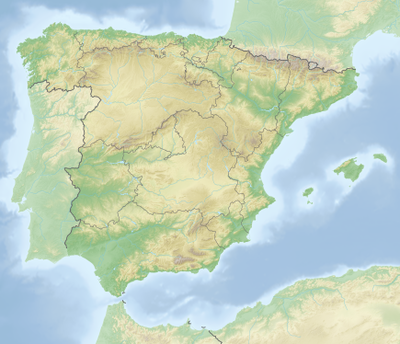Spain
![]()
The title of this article is ambiguous. For other meanings, see Spain (disambiguation).
Template:Infobox State/Maintenance/NAME-German
Spain (Spanish ![]() [esˈpaɲa], officially Kingdom of Spain, Spanish Reino de España [ˈrejno ð(e) esˈpaɲa]) is a state on the Iberian Peninsula in southwestern Europe, with the Balearic Islands in the Mediterranean Sea, the Canary Islands in the Atlantic Ocean, and two exclaves in North Africa.
[esˈpaɲa], officially Kingdom of Spain, Spanish Reino de España [ˈrejno ð(e) esˈpaɲa]) is a state on the Iberian Peninsula in southwestern Europe, with the Balearic Islands in the Mediterranean Sea, the Canary Islands in the Atlantic Ocean, and two exclaves in North Africa.
The form of government is a hereditary parliamentary monarchy. Spain is divided into 17 autonomous communities and two autonomous cities (Spanish ciudades autónomas), Ceuta and Melilla. The capital and largest metropolis is Madrid, other metropolitan areas are Barcelona, Valencia, Seville, Bilbao, Zaragoza and Málaga.
Spain is a member of the UN, the EU, the OECD and NATO. It is one of the very highly developed countries and among the 20 largest exporting and importing nations (2017). Spain is the second most visited country in the world after France.
Geography
National territory
|
|
Spain, like Portugal (to the west) and Gibraltar (to the south), which belongs to the United Kingdom, is located on the Iberian Peninsula between 36° and 43.5° north latitude and 9° west longitude and 3° east longitude (excluding the Balearic Islands, the Canary Islands, Ceuta and Melilla). Spain occupies almost six sevenths of the Iberian Peninsula. In the northeast, along the Pyrenees mountain range, Spain borders France and the small state of Andorra.
In addition, the Balearic Islands in the Mediterranean and the Canary Islands in the Atlantic as well as the cities of Ceuta and Melilla on the North African coast belong to the national territory. In France, Spain owns the exclave of Llívia. Furthermore, Spain owns several islands located directly off the Moroccan coast: Islas Chafarinas, Peñón de Alhucemas, Isla del Perejil, plus the peninsula Peñón de Vélez de la Gomera. Isla de Alborán is located 50 kilometres north of the Moroccan coast. Another group of small islands and rocks, the Islas Columbretes, is located about 55 kilometres east of Castellón de la Plana, at the same latitude as Mallorca.
The northernmost point of Spain is Estaca de Bares in Galicia, on the mainland the westernmost point is Cabo Touriñán (also in Galicia), the southernmost is Punta Marroquí near Tarifa and the easternmost is Cap de Creus on the Costa Brava. The largest extension from north to south is 856 kilometres and from east to west 1020 kilometres. The westernmost (Punta de la Orchilla) and southernmost (La Restinga) points of Spain are located on the Canary Island of El Hierro, and the easternmost on the Balearic Island of Menorca.
The national territory has a mean altitude of about 660 msnm, one of the highest values in Europe. The spatial structure of the peninsula is essentially determined by six major mountain systems.
Mountain systems
Of the six major mountain systems, five run west-east.
- In the north, the Pyrenees (up to 3404 metres) form the border to the rest of continental Europe.
- To the west of the Pyrenees, the Cantabrian Mountains run parallel to the north coast, with the highest elevations in the Picos de Europa at 2600 metres. It fans out at its western end in Galicia and northern Portugal into a multitude of lower low mountain ranges.
- Also in a west-east direction, approximately in the middle of the peninsula, runs the Castilian Divide Mountains, which are divided into different blocks and have heights up to 2600 meters. In Portugal it continues with the Serra da Estrela.
- Further south, the lower Sierra Morena (up to 1300 metres), also running from west to east, separates the central highlands from the Guadalquivir depression.
- Finally, in the extreme south, the Betic Cordillera runs along the Mediterranean coast from Gibraltar to the south of Valencia. The Balearic Islands are geologically its northeastern continuation. The highest point on the Spanish mainland and the Iberian Peninsula is Mulhacén (3482 metres) in the Sierra Nevada. The highest mountain on Spanish territory, however, is the Pico del Teide on the Canary Island of Tenerife, at 3715 metres.
The Iberian Rim Mountains, on the other hand, with altitudes up to 2300 metres, run from northwest to southeast roughly east of a Burgos-Valencia line.
Rivers
→ Main article: River systems in Spain
Between the mountain ranges run the five major river systems, four of which have an east-west orientation, flow into the Atlantic Ocean and originate in the Iberian Margin Mountains, the great watershed of the peninsula. The basin between the Cantabrian Mountains and the Castilian Sheath Mountains is drained by the Duero River. Further south, the Tagus and the Guadiana also run from east to west. The same applies to the Guadalquivir south of the Sierra Morena.
The depression between the Iberian mountain range and the Pyrenees, on the other hand, is drained to the Mediterranean by the Ebro. This river rises in the Cantabrian Mountains and runs from northwest to southeast.
Central Plateau
In the centre of the Iberian Peninsula is a vast plateau called, depending on the source, the Iberian Meseta or the Castilian Highlands, but often simply Meseta. It is bordered to the north and northwest by the Cantabrian Mountains and their foothills, to the east by the Iberian Border Mountains, and to the south by the Sierra Morena. To the southwest it merges with Extremadura, which is slightly lower but not as flat. It is divided into two halves (the northern and southern Meseta) by the Castilian Divide Mountains, the northern being slightly higher on average than the southern. The major cities of the northern meseta (Valladolid, León, Burgos, Salamanca) are located at an altitude of 700 to 900 meters, those of the southern meseta (Madrid, Toledo, Ciudad Real) at 500 to 700 meters.
Coastal plains and depressions
Much lower are the depressions through which the Guadalquivir and the Ebro flow. Since the mountains almost everywhere approach the sea, there are hardly any extended coastal plains.
Climate
The climate in Spain can be roughly divided into the following zones.
- Atlantic climate on the northern Atlantic coast: Galicia, Asturias, Cantabria, Basque Country, Navarre (north).
Precipitation especially in winter, very mild winters and summers (see climate chart of Santander). - Oceanic-continental climate in the centre of the Iberian Peninsula: Castile and Leon, Madrid, La Rioja, Navarre, Castile-La Mancha, Extremadura and Andalusia.
Very cold winters with regular snowfalls in the north and hot summers, mainly winter precipitation. - Continental Mediterranean climate in Aragon, Catalonia, Valencia (hinterland), Murcia, Castile-La Mancha and Andalusia.
Rainfall mainly in spring and autumn. Hot summers and cold winters; daily temperature variations can reach 25 °C. - Mediterranean climate in Catalonia, the Balearic Islands, Valencia, Murcia and Andalusia.
Precipitation falls mainly in spring and autumn, sometimes in cloudbursts (first week of September). Due to the decreasing amount of precipitation
from north to south (Barcelona 640 mm, Tortosa 524 mm, Valencia 454 mm, Alicante 336 mm, Almería 196 mm), the Mediterranean climate can be divided into a humid and a dry one. Temperatures are mild in winter, hot in summer, sometimes hot-humid. - Subtropical climate in the Canary Islands.
Mild temperatures (18 to 24 °C) almost all year round, winter is almost non-existent (average temperatures in Santa Cruz de Tenerife: 17.9 °C in January and 25.1 °C in August). The precipitation on the Canary Islands varies greatly in the individual regions of the islands. - Mountain climate in the highlands of the Pyrenees, the Cantabrian and Iberian Mountains, the Castilian Sheath and the Betic Cordillera.
Long, cold winters and short, fresh summers.
| Climate diagrams | |||
| Mediterranean coast | |||
| Central Spain | North Coast | Canary Islands |
|
The recent acceleration of climate change has exacerbated existing environmental problems throughout the Mediterranean region, including Spain. For five broad and interconnected impact areas (water, ecosystems, food, health and security), current changes and future scenarios consistently point to substantial and increasing risks in the coming decades. This is particularly evident in Spain. For example, UK climate economist Nicholas Stern sums up the situation for Spain in the context of the climate crisis as follows: "If temperatures rise above the limits we set in the Paris Agreement, then there is a clear risk that Spain will turn into Sahara desert." Model calculations from 2019 indicate that as early as 2050, Madrid's climate will be more similar to the current climate in Marrakech, Morocco, than it is in Madrid today. Tourism is also threatened due to the rise in sea level; the approximately 6,000 km long coastal strip will become narrower due to erosion and beaches could be permanently flooded as a result.
Flora
The vegetation of the Iberian Peninsula is divided into three major areas:
- Vegetation of the humid Spain: oaks, beeches
- Vegetation of the dry Spain: evergreen oaks (holm oaks, cork oaks), pines and palms
- Vegetation of the mountains depending on altitude: holm oaks, cork oaks, oaks, sweet chestnuts, meadows, alpine meagre grassland
Intensive cultivation of crops requires irrigation farming. However, large areas are also occupied by crops that benefit from the dry climate, such as olive trees and fig bushes.
Fauna
The Spanish fauna is extremely rich in species. The relatively sparse population has allowed species to survive in Spain that have been wiped out in the rest of Western Europe. In addition, due to the demarcation of the Iberian Peninsula by the Pyrenees, some endemic species formed.
In northwestern and central Spain, as well as sporadically in the Sierra Morena, a total of about 2500 wolves live. The Iberian wolf (Canis lupus signatus) is the largest and most stable population in Western Europe. About 200 brown bears live in the Cantabrian Mountains and the Pyrenees. While the population of Cantabrian bears is considered stable, those native to the Pyrenees are acutely threatened with extinction. The pardell lynx is a lynx species native only to Spain and Portugal, and with about 550 wild animals, it is still highly endangered in the present, despite successful conservation measures. Northern Spain is home to some of the last Western European populations of the European mink. Other characteristic mammals of Spain are the small-spotted genet, the Ichneumon, the Iberian ibex or the Pyrenean chamois, which are otherwise only found in Africa and the Near East. Three species of hare are native to Spain, the brown hare and the endemic Iberian hare and Castroviejo hare. Deer, roe deer, squirrels, rabbits, wild boar, martens, badgers and foxes are common. Mouflon and marmots are found in mountainous areas, wild cats in larger forests and otters in river basins.
Bearded vultures are native to the Pyrenees and the Cantabrian Mountains, while black, griffon and Egyptian vultures can be found in large parts of the country. Other characteristic large birds are the Spanish imperial eagle or the golden eagle. Flamingos are found in wetlands such as Coto de Doñana.
Spain's reptile fauna includes numerous lizards, geckos, skinks, creepers, snakes, land and sea turtles, such as the loggerhead turtle. Characteristic lizard species are, for example, the Canary Island lizards, especially the El Hierro giant lizard (Gallotia simonyi), which can reach a body length of up to 75 cm, and the pearl lizard, the largest lizard species in Europe.

Iberian wolf (Canis lupus signatus)

Subtropical climate in Santa Cruz de Tenerife
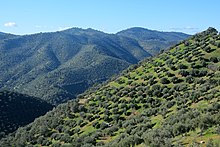
Olive groves in the mountains of Andalusia
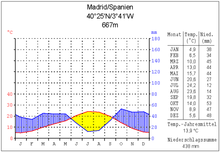
Oceanic-continental climate in Madrid
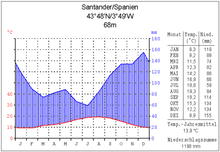
Atlantic climate in Santander

Mediterranean climate in Málaga

Mediterranean climate in Ibiza (Balearic Islands)
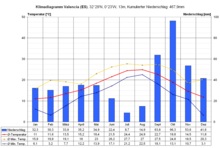
Mediterranean climate in Valencia

Mediterranean climate in Barcelona

Cantabrian Mountains
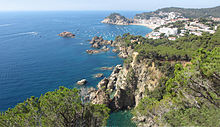
Mediterranean coastline on the Costa Brava
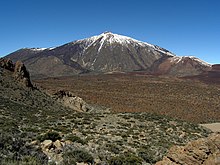
Teide, highest mountain on Spanish territory
Population
See also: Demography of Spain
Population development
Between 1999 and 2009, Spain's population increased very strongly, both compared to other European countries and compared to the decades before. For example, Spain's population increased by 1.1 million in the 1990s and by 7 million in the first decade of the 21st century. Much of the population growth was due to immigration. For example, the foreign population increased from 0.74 million in 1999 to 5.73 million in 2011. It should still be noted that there were also naturalizations. The fertility rate in Spain in 2016 was around 1.34 children per woman, below the EU average of 1.60. In 2016, the average age in Spain was 43.1 years.
| Year | thousand inhabitants | Year | thousand inhabitants | Year | thousand inhabitants | Year | thousand inhabitants | Year | thousand inhabitants |
| 1999 | 40.202 | 2004 | 43.197 | 2009 | 46.745 | 2014 | 46.771 | 2019 | 47.100 |
| 2000 | 40.499 | 2005 | 44.108 | 2010 | 47.021 | 2015 | 46.624 | ||
| 2001 | 41.116 | 2006 | 44.708 | 2011 | 47.190 | 2016 | 46.557 | ||
| 2002 | 41.837 | 2007 | 45.200 | 2012 | 47.265 | 2017 | 46.572 | ||
| 2003 | 42.717 | 2008 | 46.157 | 2013 | 47.129 | 2018 | 46.722 |
Life expectancy
The average life expectancy of Spaniards was found to be 82.5 years in 2012, the highest in the European Union, ahead of Italy (82.4) and France (82.1). Accordingly, the average life expectancy for men was 79.5 years and for women 85.5 years. In 2007, 16.7 percent of the population was older than 65. Due to the high life expectancy in combination with the low fertility, it is assumed that Spain will become one of the oldest societies in the world in the future.
Development of life expectancy
| Period | Life expectancy in years | Period | Life expectancy in years |
| 1950–1955 | 64,6 | 1985–1990 | 76,9 |
| 1955–1960 | 67,8 | 1990–1995 | 77,6 |
| 1960–1965 | 69,9 | 1995–2000 | 78,8 |
| 1965–1970 | 71,4 | 2000–2005 | 79,9 |
| 1970–1975 | 72,7 | 2005–2010 | 81,2 |
| 1975–1980 | 74,4 | 2010–2015 | 82,5 |
| 1980–1985 | 76,1 |
Source: UN
Languages
→ Main article: Languages in Spain
Spanish, Catalan, Galician and Basque are the main languages spoken in Spain. Spanish is the official language throughout the national territory. Catalan is also an official language (lenguas co-oficiales) in the autonomous communities of Catalonia, Valencia (where it is known as Valencian) and the Balearic Islands, Basque in the Basque Country and parts of Navarre, and Galician in Galicia. In the Val d'Aran, Aranese, a variety of Gascon, has official status.
The country name Kingdom of Spain in the regional languages is Galician Reino de España, Catalan Regne d'Espanya, Asturian Reinu d'España, Basque Espainiako Erresuma, Aranese Reialme d'Espanha and Aragonese Reino d'Espanya.
In addition, there are some languages that are only spoken by a small number of people and do not have the status of an official language. Among these are Asturleonesian and Aragonese. In the Jálama Valley (Cáceres province) near the Portuguese border, A Fala, a dialect of the Galician-Portuguese language, is spoken. In Melilla, the Masirian minority also speaks Tamazight.
During the holiday season, seasonal workers from Germany and Poland also work in the tourist regions, as well as South Americans in many cases. In some tourist regions, such as the Costa Blanca or the Costa del Sol, a comparatively large number of Germans and Englishmen are permanent residents.
The foreign languages spoken are mostly English and French. Younger Spaniards mostly speak English as a foreign language, older ones rather French. Among the general population, however, applicable foreign language skills are still not the rule. According to a survey conducted by Eurostat in 2011, 49% of adult Spaniards (aged 25-64) self-assess that they do not speak a foreign language. In contrast, in 2011, the percentage of primary school students learning a foreign language, usually English, was already 99% and in upper secondary 97%, with 22% also learning a second foreign language, mainly French due to its geographical proximity to France. In areas popular with tourists, particularly the Mediterranean and the Balearic Islands, English and German are sometimes used.
In Catalonia, most schools and universities teach in Catalan, but Spanish may be used by all students in classes and exams.
Minorities
Among the country's minorities are above all the "Gitanos" (Spanish Roma), who immigrated to Spain around the 16th century. Today, there are about 600,000 to 800,000 Gitanos living in Spain. The Spanish Roma are mainly located in big cities like Madrid, Barcelona, Valencia or Sevilla. They have produced some world-famous stars, such as the singer Camarón de la Isla or the football player José Antonio Reyes. Especially in the Spanish music scene, especially the flamenco, many Roma can be found.
Immigrants
| Largest migrant groups without Spanish nationality (over 100,000 pers.) | ||
| Rank | State | Population |
| 1. | Morocco | 776.425 |
| 2. | Romania | 583.795 |
| 3. | Colombia | 461.592 |
| 4. | Ecuador | 414.283 |
| 5. | Venezuela | 344.779 |
| 6. | United Kingdom | 298.140 |
| 7. | Argentina | 283.284 |
| 8. | Peru | 228.125 |
| 9. | France | 213.950 |
| 10. | Germany | 192.622 |
| 11. | China People's Republic of | 173.291 |
| 12. | Bolivia | 155.051 |
| 13. | Italy | 152.851 |
| 14. | Bulgaria | 114.564 |
| 15. | Cuba | 108.686 |
| 16. | Ukraine Ukraine | 103.950 |
| 17. | Portugal | 103.467 |
For a long time, Spain had only low immigration figures. It was not until the late 1980s that Spain became the main destination for Latin American emigration. This has led to a sharp rise in immigration to a population increase of over five million inhabitants. In 2007, there were close to 1.8 million people with a Latin American migrant background in Spain (Tedesco, 2008: 3). The number of foreigners living in Spain is around 5 million (January 2019), which is twelve per cent of the total population; of these, just over 2 million are citizens of other EU countries. Compared to the rest of the EU, Spain ranks second in absolute numbers behind Germany (7.1 million). Looking at the proportion of citizens of other countries, Spain ranks fifth behind Luxembourg (43.0%), Latvia (17.4%), Cyprus and Estonia (both 15.9%). Among Member States with more than three million inhabitants, Spain's non-national rate of 12.3% is the highest, followed by Austria (10.5%), Belgium (9.7%) and Germany (8.7%). Most immigrants come from Romania, the Maghreb countries or Latin America, as well as from the United Kingdom and Germany, for whom Spain is a popular retirement destination. Between 2003 and 2017, a total of 1,446,315 people acquired Spanish nationality.
Spaniards abroad
| Spaniards abroad (Only countries with over 50,000 pers.) | |
| Country | Number (Jan. 2020) |
| Argentina | 473.519 |
| France | 273.290 |
| United States | 167.426 |
| Germany | 167.151 |
| United Kingdom | 152.291 |
| Cuba | 147.617 |
| Mexico | 144.553 |
| Venezuela | 142.302 |
| Brazil | 133.188 |
| Switzerland | 124.414 |
| Uruguay | 67.414 |
| Belgium | 67.960 |
| Chile | 66.399 |
| Ecuador | 58.646 |
The number of Spanish citizens living abroad is around 2.6 million (January 2020), 1,576,350 of them in America and 945,027 in Europe. While only 20.6 percent of Spaniards living in America were born in Spain, this percentage is 49.7 percent for those residing in another European country. This is partly because the major waves of emigration from the mid-19th century until the Spanish Civil War were mostly to South and Central America, particularly Argentina, Venezuela, Mexico, Uruguay, and Cuba, while with the Plan de Estabilización (1959) there was a wave of emigration to European countries such as France, Germany, Switzerland, Belgium, and the United Kingdom that lasted until 1972. In addition, many immigrants from South American countries, who had in the meantime acquired Spanish nationality, left Spain in the wake of the euro crisis and returned to their home countries.
Religions and world views
Although 92 percent of the population (as of 2000) officially belonged to the Roman CatholicChurch, the number of those who actively participate in religious life is declining. In a study conducted by the state polling institute Centro de Investigaciones Sociológicas in 2015, 68 percent of respondents still said they were Catholics. The Catholic Church is financed by the Spanish state on the basis of a treaty with the Holy See and not from church taxes paid directly by its members, which is why leaving the church brings no financial benefits. Since 2007, however, taxpayers have had to decide for themselves whether 0.7% of their income tax should go to church or other social or cultural purposes. If they do not make a decision, this obligatory tax amount is directly allocated to the other purposes. Direct state funding, which had existed since 1979, has been completely abolished. Between 1988 and 2007, taxpayers could decide whether 0.5% of their income tax should go to church or other purposes. However, at that time, if the amount fell short of a minimum amount, the state paid for it. In 2008, in 7,195,155 (34.31%) tax returns, this 0.7% was donated to the Catholic Church. Two years earlier, it had been about 711,975 less. The income from taxes thus rose from 173.8 million euros to 252.7 million euros since the new regulation of 2007.
It is not readily possible for Spain's Catholics to officially renounce the Church, since Spanish law does not recognize the act of leaving the Church, and Spain's Catholic Church was relieved by the highest court of the obligation to erase the data of its members from the church records at their request. This decision by the highest court in Spain came about, among other things, because "the Archbishopric of Valencia, which is considered particularly conservative, refused to carry out erasures of any form". The archdiocese had not been impressed by the instructions of the Spanish data protection authority (AEPD) and had initiated numerous legal proceedings, losing 171 cases before the decision of the Supreme Court.
A larger minority of 15.9% of the population describes itself as non-religious and 9.5% as atheist, according to the aforementioned study. According to a study by the Pew Research Center, 46% of Spaniards describe themselves as "religious" and 19% as "very religious". Among 18-39 year olds, only a minority of 9% are very religious; in the world, the figure is only lower in France and Japan, where, moreover, the figures for 39-59 year olds are only marginally higher. According to a representative survey by Eurobarometer, 59% of people in Spain believed in God in 2005, with a further 21% believing in some other spiritual force. 18 % percent of the respondents believed neither in a God nor in another spiritual force, 2 % of the respondents were undecided.
Muslims make up 4.13% (as of the end of 2016), Protestants 0.3% and Jehovah's Witnesses 0.25% of the population. Spain is home to the important pilgrimage site of Santiago de Compostela, the destination of many pilgrims on the Way of St. James.
See also: Roman Catholic Church in Spain, Spanish Protestant Church, and History of the Jews in Spain.
Largest cities
→ Main article: List of cities in Spain
Spain has two cities with over a million inhabitants, Madrid and Barcelona. However, the strong growth of the cities in recent years has led to the emergence of metropolitan regions, some of which extend far beyond the political-administrative boundaries of the municipalities. The metropolitan areas of Madrid and Barcelona are home to over six and four million people respectively, while the metropolitan regions of Valencia, Seville and Bilbao each have over one million inhabitants.
The ten largest cities (as of 1 January 2019)
| City | Inhabitants |
| Madrid | 3.266.126 |
| Barcelona | 1.636.762 |
| Valencia | 794.288 |
| Sevilla | 688.592 |
| Zaragoza | 674.997 |
| Málaga | 574.654 |
| Murcia | 453.258 |
| Palma de Mallorca | 416.065 |
| Las Palmas de Gran Canaria | 379.925 |
| Bilbao | 346.843 |
Autonomous Communities by population
The total of 17 autonomous communities are very heterogeneous in size. While the populations of Andalusia, Catalonia, the Autonomous Community of Madrid and the Valencia region range from around 5 to 9 million, the smallest regions of Navarre, Cantabria and La Rioja are home to well under one million people. (As of January 1, 2019)
| Autonomous community | Inhabitants |
| Andalusia | 8.410.002 |
| Catalonia | 7.672.699 |
| Madrid | 6.661.949 |
| Valencia | 5.000.868 |
| Galicia | 2.698.875 |
| Castile and Leon | 2.398.214 |
| Basque Country | 2.206.965 |
| Canary Islands | 2.152.590 |
| Castile-La Mancha | 2.032.004 |
| Region of Murcia | 1.493.530 |
| Aragon | 1.318.453 |
| Balearic Islands | 1.148.947 |
| Extremadura | 1.066.998 |
| Asturias | 1.022.670 |
| Navarre | 653.846 |
| Cantabria | 580.964 |
| La Rioja | 316.551 |
| Autonomous city | Inhabitants |
| Ceuta | 84.777 |
| Melilla | 86.465 |
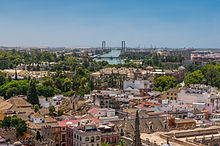
View over Seville from the Giralda, the cathedral of Seville

The Ciudad de las Artes y de las Ciencias, the landmark of Valencia
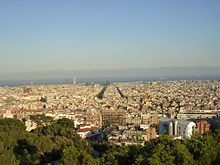
View from Parc Güell over Barcelona
_04.jpg)
Center of Madrid by night
.jpg)
The Cathedral of Santiago de Compostela: destination of the pilgrims of the Way of St. James

Spread of languages in the Iberian Peninsula from the 13th to the 21st century: Castilian only Catalan Aragonese Basque Asturleonic Galician-Portuguese Arabic
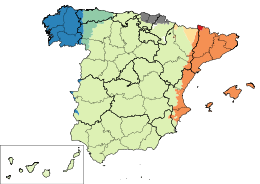
Languages in Spain: Castilian only Catalan Basque Galician Asturleones Aragonese Aranese
.svg.png)
Population density in Spain 2018

Population pyramid of Spain 2016
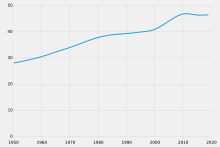
Population development in millions of inhabitants
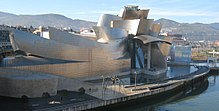
The Guggenheim Museum in Bilbao
Questions and Answers
Q: What is the name of the people from Spain?
A: The people of Spain are called Spaniards.
Q: What languages do they speak in Spain?
A: In Spain, they speak Castilian or Spanish (in Spanish, "Castellano", from Castilla, or "Español"). They also speak other languages in some parts of the country including Catalan, Basque, Asturian, Galician, Leonese, Aragonese, Aranese Occitan and even Portuguese.
Q: What is the religion of most people in Spain?
A: About 56% of the population in Spain is Roman Catholic.
Q: How does the government work in Spain?
A: Since 1975, Spain has had a constitutional monarchy. The King of Spain is Felipe VI; he only does what the constitution allows him to. The parliament is called "Las Cortes Generales," and has two bodies - "El Congreso" (The Congress) and "El Senado" (The Senate) - which are chosen by voting by the Spanish people. The Prime minister is Pedro Sánchez.
Q: Where is Madrid located?
A: Madrid is located in central-western part of mainland Europe and it serves as both capital city and largest city for all of Spain.
Q: How big is Spain compared to other countries?
A:Spain has more than five hundred thousand square kilometres of land which makes it smaller than France but bigger than Germany.
Q: How many autonomous communities does spain have?
A:Spain has 17 autonomous communities which means that each community can decide upon some affairs themselves.
Search within the encyclopedia
